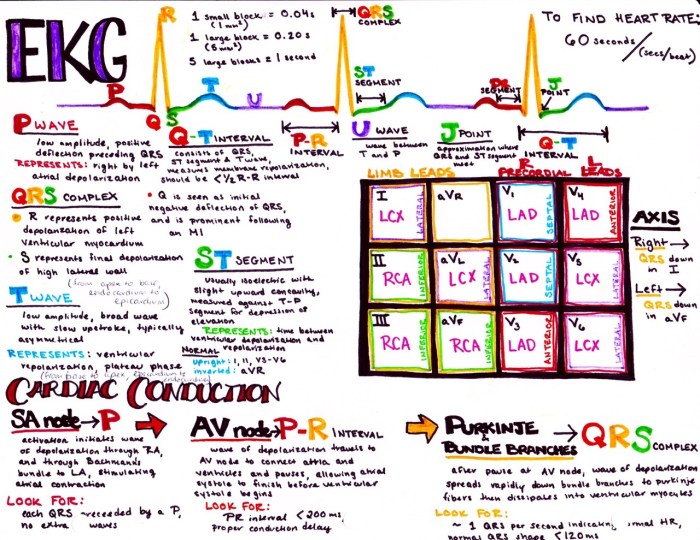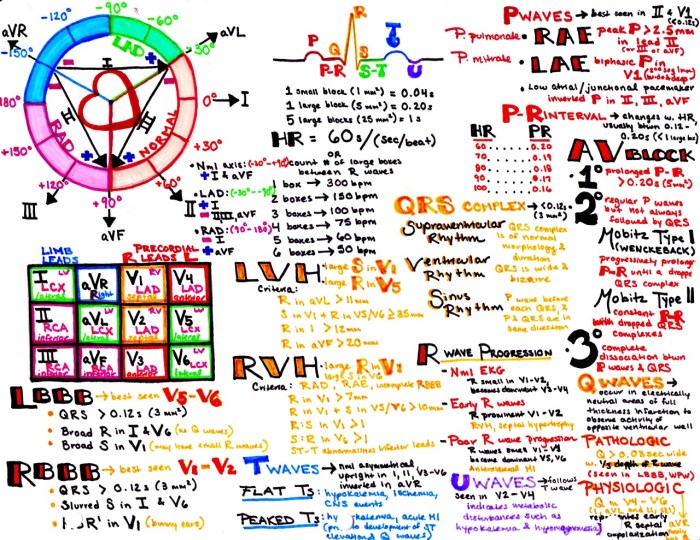Delve into the realm of electrocardiography with the NHA EKG study guide PDF, an indispensable resource that empowers you to decipher the intricate language of the heart. This comprehensive guide serves as your steadfast companion, providing a clear understanding of EKG basics, rhythm interpretation, and abnormality identification.
As you navigate the complexities of EKG analysis, this study guide illuminates the path with clarity and precision. Prepare to unlock the secrets of the heart’s electrical activity and elevate your EKG interpretation skills to new heights.
NHA EKG Study Guide PDF
The NHA EKG Study Guide PDF is a comprehensive resource designed to help students prepare for the National Healthcareer Association (NHA) EKG certification exam.
This study guide provides a thorough review of the essential concepts and skills required for EKG interpretation, including anatomy and physiology of the heart, principles of EKG recording, and common EKG abnormalities.
Target Audience
The NHA EKG Study Guide PDF is primarily intended for individuals preparing for the NHA EKG certification exam. It is also beneficial for healthcare professionals who wish to enhance their EKG interpretation skills.
Understanding EKG Basics
Electrocardiography (EKG) is a non-invasive medical test that records the electrical activity of the heart. It is a valuable tool for diagnosing and monitoring heart conditions, such as arrhythmias, heart attacks, and heart failure.
An EKG tracing consists of a series of waves that represent the electrical impulses generated by the heart’s electrical system. The main components of an EKG tracing include the P wave, QRS complex, and T wave. The P wave represents atrial depolarization, the QRS complex represents ventricular depolarization, and the T wave represents ventricular repolarization.
Types of EKG Leads
There are 12 standard EKG leads that are used to record the electrical activity of the heart from different angles. The leads are placed on the chest, arms, and legs. The different types of leads include:
- Limb leads (I, II, III)
- Chest leads (V1-V6)
- Augmented limb leads (aVR, aVL, aVF)
Interpreting EKG Rhythms: Nha Ekg Study Guide Pdf

Interpreting EKG rhythms is a fundamental skill for healthcare professionals, as it allows them to identify and diagnose various cardiac conditions. By analyzing the electrical activity of the heart, as represented by the EKG, healthcare providers can assess the heart’s rate, rhythm, and any abnormalities.
Types of EKG Rhythms
There are several different types of EKG rhythms, each with its own unique characteristics and clinical implications. Some of the most common rhythms include:
- Sinus rhythm: This is the normal rhythm of the heart, characterized by a regular P wave followed by a QRS complex and a T wave.
- Atrial fibrillation: This is an irregular rhythm caused by disorganized electrical activity in the atria. It is often associated with an increased risk of stroke and heart failure.
- Ventricular tachycardia: This is a rapid heart rhythm that originates in the ventricles. It can be life-threatening if not treated promptly.
- Bradycardia: This is a slow heart rhythm, characterized by a heart rate of less than 60 beats per minute.
- Tachycardia: This is a fast heart rhythm, characterized by a heart rate of more than 100 beats per minute.
Diagnosing EKG Rhythms
Diagnosing EKG rhythms involves analyzing the following characteristics:
- Heart rate: The number of beats per minute.
- Rhythm: The regularity or irregularity of the beats.
- P wave: The first wave of the EKG, which represents the electrical activity of the atria.
- QRS complex: The second wave of the EKG, which represents the electrical activity of the ventricles.
- T wave: The third wave of the EKG, which represents the repolarization of the ventricles.
By analyzing these characteristics, healthcare providers can identify and diagnose various EKG rhythms and determine their clinical implications.
Clinical Implications of EKG Rhythms
Different EKG rhythms can have different clinical implications. For example, sinus rhythm is the normal rhythm of the heart and is not typically associated with any underlying cardiac conditions. Atrial fibrillation, on the other hand, is an irregular rhythm that can increase the risk of stroke and heart failure.
Ventricular tachycardia is a rapid heart rhythm that can be life-threatening if not treated promptly. Bradycardia is a slow heart rhythm that can cause symptoms such as fatigue, dizziness, and shortness of breath. Tachycardia is a fast heart rhythm that can be caused by a variety of conditions, including stress, anxiety, and certain medications.
By interpreting EKG rhythms, healthcare providers can identify and diagnose cardiac conditions and determine the appropriate course of treatment.
Identifying EKG Abnormalities
EKG abnormalities can provide valuable insights into the electrical activity of the heart, helping diagnose various cardiac conditions. Understanding these abnormalities and their clinical significance is crucial for accurate EKG interpretation.
The lambda chi coat of arms is a unique symbol of the fraternity, representing its values and history. It’s an interesting topic to explore, but if you’re currently studying for your NHA EKG exam, I recommend focusing on the official study guide PDF for the most comprehensive and up-to-date information.
Common EKG abnormalities include arrhythmias, conduction disturbances, and myocardial ischemia/infarction. Each abnormality has specific diagnostic criteria and clinical implications.
Arrhythmias
- Bradycardia:Heart rate below 60 bpm, indicating a slow heart rate.
- Tachycardia:Heart rate above 100 bpm, indicating a fast heart rate.
- Premature atrial contractions (PACs):Early atrial beats originating from the atria.
- Premature ventricular contractions (PVCs):Early ventricular beats originating from the ventricles.
- Atrial fibrillation (AFib):Irregular atrial activity without a clear P wave.
- Ventricular tachycardia (VT):Rapid ventricular rhythm with a rate greater than 100 bpm.
- Ventricular fibrillation (VF):Irregular, chaotic ventricular activity indicating cardiac arrest.
Conduction Disturbances
- First-degree atrioventricular (AV) block:Prolonged PR interval without dropped beats.
- Second-degree AV block:Dropped beats with varying PR intervals.
- Third-degree AV block:Complete AV dissociation, with independent atrial and ventricular activity.
- Bundle branch block:Widened QRS complex due to conduction delay in the bundle branches.
- Wolff-Parkinson-White (WPW) syndrome:Pre-excitation of the ventricles due to an accessory pathway.
Myocardial Ischemia/Infarction, Nha ekg study guide pdf
- ST-segment elevation:Elevation of the ST segment above the isoelectric line, indicating myocardial ischemia or infarction.
- ST-segment depression:Depression of the ST segment below the isoelectric line, indicating myocardial ischemia.
- T-wave inversion:Inversion of the T wave, indicating myocardial injury or ischemia.
- Q waves:Deep, wide Q waves in multiple leads, indicating myocardial infarction.
EKG abnormalities provide valuable information about the heart’s electrical activity and can help diagnose a wide range of cardiac conditions. Accurate interpretation of these abnormalities is essential for appropriate patient management.
Using the NHA EKG Study Guide PDF
The NHA EKG Study Guide PDF is a comprehensive resource designed to help you prepare for the NHA EKG certification exam. It covers all the essential topics you need to know, including:
- Understanding EKG basics
- Interpreting EKG rhythms
- Identifying EKG abnormalities
The study guide is well-organized and easy to follow. It starts with a review of basic EKG concepts, such as the electrical conduction system of the heart and the different types of EKG leads. It then moves on to more advanced topics, such as interpreting EKG rhythms and identifying EKG abnormalities.Each
chapter includes a variety of learning aids, such as:
- Case studies
- Practice questions
- Glossary of terms
These learning aids help you to reinforce your understanding of the material and prepare for the exam.
How to Effectively Use the Study Guide
To get the most out of the NHA EKG Study Guide PDF, it is important to use it effectively. Here are a few tips:
- Read the study guide carefully and take notes.
- Complete the practice questions at the end of each chapter.
- Review the glossary of terms regularly.
- Use the case studies to apply your knowledge to real-world situations.
By following these tips, you can maximize your learning outcomes and prepare yourself for success on the NHA EKG certification exam.
Additional Resources

In addition to the NHA EKG study guide PDF, here are some other resources that can help you prepare for the NHA EKG certification exam:
- Online courses:Several online courses are available that can teach you the basics of EKG interpretation. These courses typically include interactive exercises and practice tests.
- Practice tests:There are many practice tests available online that can help you assess your knowledge of EKG interpretation. Taking practice tests can help you identify areas where you need additional study.
- References:Several books and articles are available that can provide you with additional information on EKG interpretation. These resources can be helpful for further reading and research.
References
- Bower, R. (2019). ECG interpretation: A practical approach. Lippincott Williams & Wilkins.
- Camm, A. J., & Malik, M. (2017). Clinical arrhythmology and electrophysiology. John Wiley & Sons.
- Marriott, H. J. (2012). Marriott’s practical electrocardiography. Lippincott Williams & Wilkins.
To access the NHA EKG study guide PDF, please visit the NHA website.
Essential FAQs
What is the purpose of the NHA EKG study guide PDF?
The NHA EKG study guide PDF provides a comprehensive overview of EKG interpretation, covering EKG basics, rhythm analysis, and abnormality identification.
Who is the target audience for this study guide?
This study guide is designed for individuals seeking to enhance their EKG interpretation skills, including nurses, medical students, and healthcare professionals.
How can I effectively use the NHA EKG study guide PDF?
Follow the guide’s structured content, engage with the interactive exercises, and utilize the practice questions to reinforce your understanding.